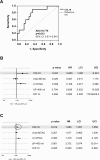Sustained low peritoneal effluent CCL18 levels are associated with preservation of peritoneal membrane function in peritoneal dialysis
- PMID: 28414753
- PMCID: PMC5393879
- DOI: 10.1371/journal.pone.0175835
Sustained low peritoneal effluent CCL18 levels are associated with preservation of peritoneal membrane function in peritoneal dialysis
Abstract
Peritoneal membrane failure (PMF) and, ultimately, encapsulating peritoneal sclerosis (EPS) are the most serious peritoneal dialysis (PD) complications. Combining clinical and peritoneal transport data with the measurement of molecular biomarkers, such as the chemokine CCL18, would improve the complex diagnosis and management of PMF. We measured CCL18 levels in 43 patients' effluent and serum at baseline and after 1, 2, and 3 years of PD treatment by retrospective longitudinal study, and evaluated their association with PMF/EPS development and peritoneal risk factors. To confirm the trends observed in the longitudinal study, a cross-sectional study was performed on 61 isolated samples from long-term (more than 3 years) patients treated with PD. We observed that the patients with no membrane dysfunction showed sustained low CCL18 levels in peritoneal effluent over time. An increase in CCL18 levels at any time was predictive of PMF development (final CCL18 increase over baseline, p = .014; and maximum CCL18 increase, p = .039). At year 3 of PD, CCL18 values in effluent under 3.15 ng/ml showed an 89.5% negative predictive value, and higher levels were associated with later PMF (odds ratio 4.3; 95% CI 0.90-20.89; p = .067). Moreover, CCL18 levels in effluent at year 3 of PD were independently associated with a risk of PMF development, adjusted for the classical (water and creatinine) peritoneal transport parameters. These trends were confirmed in a cross-sectional study of 61 long-term patients treated with PD. In conclusion, our study shows the diagnostic capacity of chemokine CCL18 levels in peritoneal effluent to predict PMF and suggests CCL18 as a new marker and mediator of this serious condition as well as a new potential therapeutic target.
Conflict of interest statement
Figures






References
-
- De Sousa-Amorim E, Del Peso G, Bajo MA, Alvarez L, Ossorio M, Gil F, et al. Can EPS development be avoided with early interventions? The potential role of tamoxifen—a single-center study. Perit Dial Int. 2014;34:582–593. doi: 10.3747/pdi.2012.00286 - DOI - PMC - PubMed
-
- Johnson DW, Cho Y, Livingston BE, Hawley CM, McDonald SP, Brown FG, et al. Encapsulating peritoneal sclerosis: incidence, predictors, and outcomes. Kidney Int. 2010;77:904–912. doi: 10.1038/ki.2010.16 - DOI - PubMed
-
- Del Peso G, Jiménez-Heffernan JA, Bajo MA, Aroeira LS, Aguilera A, Fernández-Perpén A, et al. Epithelial-to-mesenchymal transition of mesothelial cells is an early event during peritoneal dialysis and is associated with high peritoneal transport. Kidney Int. 2008;73 (Suppl 108):S26–S33. - PubMed
-
- Goodlad C, Tam FW, Ahmad S, Bhangal G, North BV, Brown EA. Dyalisate cytokine levels do not predict encapsuating peritoneal sclerosis. Perit Dial Int. 2014;34:594–604. doi: 10.3747/pdi.2012.00305 - DOI - PMC - PubMed
-
- Balasubramaniam G, Brown EA, Davenport A, Cairns H, Cooper B, Fan SL, et al. The Pan-Thames EPS study: treatment and outcomes of encapsulating peritoneal sclerosis. Nephrol Dial Transplant. 2009;24:3204–3215. - PubMed
MeSH terms
Substances
LinkOut - more resources
Full Text Sources
Other Literature Sources

